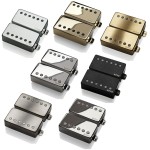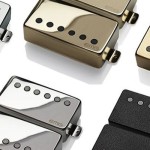Language
EMG 57/66 Guitar Humbucker Set Review
When you think about manufacturers that are well known for pickups that specialize in vintage tones, you don’t usually think EMG. Instead, they are better known for pickups that are especially suited for hard rock and metal. With that said, I was very interested in checking out their 57 Bridge and the 66 Neck set, which are essentially vintage PAF-style humbuckers, albeit with an active system onboard.
 EMG 57/66 Humbucker Set starting @ $229.99
A true original, the 57 is a bridge pickup designed for today's player regardless of style or genre. The unique combination of Alnico V magnets and steel pole pieces evoke an unmistakably PAF-like quality in its tone. The active attributes provide the headroom and punch necessary to deliver unparalleled definition and presence. The 66 is a result of pickup design innovation inspired by the specific needs and requests of today's players. Alnico V magnets provide the warm, smooth mid-range and expansive lows while the ceramic pole pieces bring out the clarity in the upper register.
EMG 57/66 Humbucker Set starting @ $229.99
A true original, the 57 is a bridge pickup designed for today's player regardless of style or genre. The unique combination of Alnico V magnets and steel pole pieces evoke an unmistakably PAF-like quality in its tone. The active attributes provide the headroom and punch necessary to deliver unparalleled definition and presence. The 66 is a result of pickup design innovation inspired by the specific needs and requests of today's players. Alnico V magnets provide the warm, smooth mid-range and expansive lows while the ceramic pole pieces bring out the clarity in the upper register.
The Features
First off, both the 57 and 66 feature alnico 5 magnets which mean these pickups should offer a smoother, stronger midrange than the ceramic magnets used in most EMGs. The pole pieces on the 66 are still ceramic although the 57 comes equipped with steel pieces instead. The 57/66 come in multiple looks including a brushed chrome casing which retains EMG’s classic look with a bit of a vintage flair. Other styles include gold, black, black chrome and more. Each also comes with an EMG solder-less kit consisting of a pair of 25k volume and tone pots, a 9V battery clip, wiring, mounting hardware, a small circuit board with slots for snapping components into place and of course an output jack. If you are particularly well versed in soldering, you can always solder the wiring from the pickup switch onto the pads on the board if you don’t want to clamp them down with the included set of screws. Loading the set onto any humbucker compatible guitar should be a piece of cake. Seriously – you probably won’t find a set of pickups that install as easily as these. EMG 57/66 Humbucker Set starting @ $229.99
A true original, the 57 is a bridge pickup designed for today's player regardless of style or genre. The unique combination of Alnico V magnets and steel pole pieces evoke an unmistakably PAF-like quality in its tone. The active attributes provide the headroom and punch necessary to deliver unparalleled definition and presence. The 66 is a result of pickup design innovation inspired by the specific needs and requests of today's players. Alnico V magnets provide the warm, smooth mid-range and expansive lows while the ceramic pole pieces bring out the clarity in the upper register.
EMG 57/66 Humbucker Set starting @ $229.99
A true original, the 57 is a bridge pickup designed for today's player regardless of style or genre. The unique combination of Alnico V magnets and steel pole pieces evoke an unmistakably PAF-like quality in its tone. The active attributes provide the headroom and punch necessary to deliver unparalleled definition and presence. The 66 is a result of pickup design innovation inspired by the specific needs and requests of today's players. Alnico V magnets provide the warm, smooth mid-range and expansive lows while the ceramic pole pieces bring out the clarity in the upper register.

